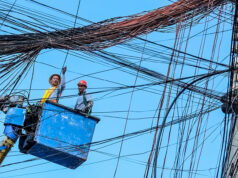PHL restaurants pin recovery hopes on ‘revenge dining’

THE RESTAURANT industry is anticipating some recovery next year modeled after the resurgence seen in major global cities like New York and Hong Kong that reopened their economies, the Restaurant Owners of the Philippines (Resto PH) head said.
“There is hope for us when you look at the restaurant industry for the Philippines. There should be a resurgence, what we call ‘revenge dining’… that might happen next year,” Resto PH President Eric Teng said at a Philippine Chamber of Commerce and Industry forum on Friday.
The restaurant industries in some major cities are already experiencing growth higher than 100% of pre-pandemic levels, he said, adding that restaurants in key cities in China are also seeing a resurgence.
Since the start of the lockdowns declared to contain the coronavirus disease 2019 (COVID-19) last year, restaurants have seen drastically lower demand due to limited consumer mobility and ongoing restrictions on dine-in capacity.
Mr. Teng said that improved vaccination levels are encouraging, hoping that the rates would be enough to ease public health fears leading up to the holidays.
He said that there is a dearth of assistance in the form of relief packages or overt eviction moratoriums for businesses affected by lockdown restrictions.
“Tax breaks, tax holidays and other remedial packages that local, National Government can offer can go a long way in having us reinvest in our own businesses or in our industries,” he said. “It’s a shame if we cannot reinvigorate the restaurant industry again.”
Restaurants operating in areas under Alert Level 4 such as Metro Manila are allowed to run up to 10% indoor dine-in for fully vaccinated customers. Outdoor dining can operate up to 30% capacity.
Around 6.2 million individuals or 63% of the capital region’s eligible population has been fully vaccinated against COVID-19, Metro Manila Development Authority Chairman Benjamin de Castro Abalos, Jr. said on Friday.
The national rate is under 17%, the Johns Hopkins University COVID-19 tracker showed. The Philippines aims to inoculate 70% of its population by end-2021.
TOURISM RECOVERY
Meanwhile, the tourism sector will have to generate at least 50% of its P3.14 trillion income from domestic travel in 2019 to recover from the coronavirus pandemic, an industry group said.
“Our target now is at least half of that P3 trillion is more than enough for the tourism recovery in the Philippines,” Cesar R. Cruz, president of the Philippine Tour Operators Association (PHILTOA), said during Thursday’s hybrid press conference for the Philippine Travel Exchange 2021 held virtually and physically at the Subic Bay Freeport Zone.
Mr. Cruz said PHILTOA, which also includes members from the hotel, transport and other allied sectors, is “very optimistic” that the industry can get back on its feet by the end of 2022 given the local market’s eagerness to get out of their homes after more than a year in lockdown.
Their promotional strategy now, he said, is initially focused on land trips as domestic air travel faces more restrictions and documentary requirements.
For international visitors, Tourism Secretary Bernadette Romulo-Puyat said they are closely watching the “Phuket model or sandbox model” in Thailand, which has reopened to fully vaccinated foreign guests without a quarantine requirement.
Ms. Puyat stressed that a key factor to border reopening is having the entire tourism workforce fully vaccinated.
She cited that popular tourist destination Boracay already has a 73% vaccination rate. Other island destinations such as Cebu, Bohol, Palawan, and Siargao are also being prioritized.
“Hopefully we can vaccinate everyone (in the tourism establishments) at least before the end of the year, then we can accept vaccinated foreign tourists, and hopefully without quarantine days,” Ms. Puyat said.
Maria Anthonette Velasco-Allones, chief operating officer of the Tourism Promotions Board that organized the Philippine Travel Exchange, said there was a lot of interest in the event’s business-to-business meetings for resumption of travel among the country’s major foreign markets such as South Korea, China, and Japan as well as Spain.
The tourism sector was on a steady growth from 2017 to 2019, contributing 11.7%-12.7% to the country’s economy, based on data from the Philippine Statistics Authority.
Foreign tourist expenditure in 2019, including those from non-resident Filipinos, reached P548.76 billion.
In 2020, the Tourism Direct Gross Value Added dropped to P973.31 billion and the sector’s contribution to the economy declined to 5.4%. Domestic tourism expenditure decreased by 82.3%, while inbound visitor receipts went down by 78%.
In terms of employment, the industry had an estimated 5.71 million workers in 2019, which dropped to 4.68 million in 2020. — Jenina P. Ibañez and Marifi S. Jara



